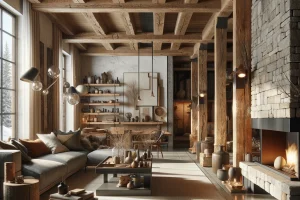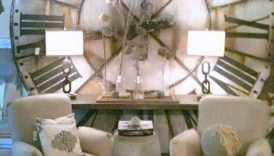Rustic Revival: Bringing Old-World Charm to Modern Spaces

Defining Rustic Revival
Rustic Revival is a design movement that seeks to blend the charm of the past with the comforts of modern living. This style emphasizes natural materials, earthy colors, and a warm, welcoming atmosphere. By incorporating elements such as reclaimed wood, vintage furniture, and handmade decor, Rustic Revival creates an environment that feels both timeless and inviting. Imagine stepping into a home where the walls are adorned with an array of wooden textures, the air carries the faint scent of aged timber, and furniture pieces tell stories of a bygone era. This isn’t just a trend; it’s a lifestyle choice that appeals to those yearning for a connection to nature and history. Some key characteristics of Rustic Revival include:
- Rustic Revival: Bringing Old-World Charm to Modern Spaces
- Defining Rustic Revival
- History of Old-World Charm
- Elements of Rustic Revival
- Reclaimed Wood
- Benefits of Reclaimed Wood:
- Antique Furniture
- Colors and Textures
- Earthy Tones
- Benefits of Earthy Tones:
- Textured Fabrics
- Popular Textured Fabrics Include:
- Incorporating Natural Elements
- Stone Accents
- Popular Uses of Stone Accents:
- Indoor Plants
- Best Indoor Plants for Rustic Spaces:
- Lighting Techniques
- Exposed Bulbs
- Key Benefits of Exposed Bulbs:
- Vintage-inspired Fixtures
- Popular Styles of Vintage-inspired Fixtures:
- Use of reclaimed and salvaged materials
- A focus on artisan craftsmanship
- An emphasis on simplicity and functionality
- Incorporation of local and natural resources
This style resonates particularly with individuals who want their homes to exude authenticity and warmth, creating a space where memories can be cherished with family and friends.
History of Old-World Charm
The allure of old-world charm traces back to centuries past, during times when craftsmanship took precedence over mass production. In the heart of Europe, craftspeople would often employ time-honored techniques to create furniture and décor that echoed the simplicity and elegance of rural life. This historical context laid the groundwork for what would later evolve into the Rustic Revival movement. In the early 20th century, the Arts and Crafts movement embraced this philosophy, focusing on handmade craftsmanship as a response to industrialization. With a renewed interest in quality materials and traditional methods, home designers began to revive rustic themes, emphasizing function while celebrating beauty. Fast forward to today, and the Rustic Revival is gaining momentum as homeowners look to create spaces that feel grounded and inviting. For instance, many individuals are opting for rustic kitchens with open shelving, mismatched tableware, and exposed beams that harken back to old-world charm. This nostalgic style not only beautifies spaces but also fosters a sense of connection and belonging—a fundamental aspect of lifestyle in our fast-paced world. Ultimately, Rustic Revival is more than a design choice; it’s a way to encapsulate history, craftsmanship, and nature within the heart of the home.
Elements of Rustic Revival
Reclaimed Wood
One of the standout elements of Rustic Revival is the use of reclaimed wood. This isn’t just any timber; reclaimed wood has a story to tell, having been salvaged from old structures, barns, or even shipping pallets. The rough textures and unique imperfections breathe character into a space, making it feel lived-in and warm. When you choose reclaimed wood, you’re not only opting for sustainability but also embracing individuality. Each piece carries its own history and charm, which establishes a connection between the old and the new. Think about rustic kitchen countertops made from repurposed barn wood or dining tables that showcase the character of old hardwood beams.
Benefits of Reclaimed Wood:
- Sustainability: Reclaimed wood reduces the demand for new timber, helping to preserve forests.
- Unique Character: No two pieces are the same, offering distinct textures and colors.
- Durability: Often, reclaimed wood comes from old-growth trees, which can be denser and more durable than newer varieties.
For instance, a friend of mine recently renovated her dining room with a stunning reclaimed table she discovered at a flea market. Each knot and faded patina adds a layer of history to family gatherings, bringing her loved ones closer while cherishing old memories.
Antique Furniture
Complementing reclaimed wood is antique furniture, another essential element of the Rustic Revival aesthetic. These vintage pieces offer timeless beauty and craftsmanship that modern furniture often lacks. From Victorian chairs to rustic sideboards, incorporating antique furniture into a home allows individuals to create spaces that resonate with authenticity. Among the most cherished antique pieces are:
- Farmhouse Dining Tables: Large enough to gather family and friends, these tables often have character-rich scars and marks.
- Vintage Dressers: Often crafted from solid wood, adding storage and style in a charming way.
- Repurposed Armoires: Perfect for displaying decorative items while offering functional storage.
A memorable moment was when a family member inherited a beautiful antique wardrobe from their grandmother. Not only did it serve as practical storage, but it also became a conversation piece rich with stories and history, adding depth to their rustic-inspired home. Integrating reclaimed wood and antique furniture reinforces the values of Rustic Revival—natural beauty, sustainability, and a profound connection to history. Together, they create inviting spaces that tell a story, making every corner a celebration of the past while enhancing everyday life.
Colors and Textures
Earthy Tones
When it comes to creating a Rustic Revival atmosphere, earthy tones play a fundamental role in setting the right vibe. These soft, muted colors—think browns, greens, ochres, and terracottas—evoke a sense of calm and comfort reminiscent of nature. Using these hues throughout your home not only reflects the beauty of the outdoors but also enhances the organic feel that is essential to the rustic aesthetic. Imagine stepping into a living room painted in a warm taupe, complemented by olive green accents and deep browns from reclaimed wood furniture. The color palette feels inviting and evokes a sense of tranquility, making it the perfect place to unwind.
Benefits of Earthy Tones:
- Enhance Space: Earthy shades can make spaces feel larger and more open by connecting indoor and outdoor elements.
- Versatility: These colors blend seamlessly with a variety of decor styles, whether it’s modern, traditional, or eclectic.
- Mood Setting: Earthy tones promote relaxation and emotional well-being, perfect for creating a restful sanctuary.
For example, a friend recently revamped her home office with warm beige walls and dark brown shelving. She said the change made a noticeable difference in her productivity and mood, turning her workspace into a cozy nook that drew inspiration from nature.
Textured Fabrics
In addition to color, textures play a significant role in achieving the Rustic Revival look. Incorporating various textured fabrics adds depth and interest to a space while promoting that feel of comfort and warmth. From soft linens and velvety cushions to chunky knits and rugged burlaps, mixing textures invites a tactile experience that is both inviting and rich.
Popular Textured Fabrics Include:
- Linen: Soft, breathable, and perfect for draperies or upholstery, adding a light organic feel.
- Wool: Ideal for throws or rugs, offering warmth and a rustic touch.
- Canvas: Sturdy and versatile, great for accent pillows or wall art.
One memorable example is how a family member styled her rustic living room with a mix of linen curtains and a woolen throw over a distressed leather sofa. The combination not only added warmth but also visually connected the space to nature with earthy colors and cozy textures. Ultimately, blending earthy tones with diverse textured fabrics creates a foundation for the Rustic Revival aesthetic. This combination enhances the home’s cozy appeal while fostering a connection to nature, welcoming family and friends to share in its warmth and charm.
Incorporating Natural Elements
Stone Accents
Integrating natural elements like stone accents is a pivotal aspect of the Rustic Revival style. Stone not only adds a raw, organic touch but also conveys durability and authenticity. Whether it’s a stunning fireplace made from rough-cut stones or a rustic stone accent wall, these features ground a space in nature and evoke a sense of timelessness.
Popular Uses of Stone Accents:
- Fireplace Surrounds: A stone fireplace serves as the focal point of a living room, offering warmth both physically and aesthetically.
- Accent Walls: A single wall made of stacked stone can transform a room, adding character and visual interest.
- Outdoor Spaces: Incorporating natural stone in patios or walkways enhances the connection to nature and brings the feeling of the outdoors inside.
For instance, a friend recently renovated her cabin in the woods. She chose to use locally sourced river stones for the fireplace, capturing the essence of her surroundings. The result was a cozy gathering spot that seamlessly blended with the rustic landscape outside.
Indoor Plants
Moving from stone to another essential natural element, indoor plants breathe life into any space, enriching the Rustic Revival aesthetic even further. Plants not only enhance air quality but also inject color and texture, creating a welcoming environment that feels alive and vibrant.
Best Indoor Plants for Rustic Spaces:
- Fiddle Leaf Fig: With its large, dramatic leaves, it can serve as a stunning focal point.
- Snake Plant: Easy to care for and resilient, this plant complements rustic décor perfectly with its upright, architectural form.
- Pothos: Known for its trailing vines, pothos can elegantly drape from shelves or hang from window sills, adding a touch of greenery at various heights.
One of my favorite home transformations involved a family member who added a variety of indoor plants to their rustic dining area. They filled a vintage wooden crate with herbs, while pots of trailing ivy adorned the window sills. The greenery not only brightened the space but also fostered a soothing ambiance during family dinners, as they shared stories over fresh basil pesto made with ingredients grown right at home. Bringing together stone accents and indoor plants anchors the Rustic Revival style in nature and creates a harmonious blend of textures and elements. This combination not only enhances the visual appeal of a space but also cultivates a sense of tranquility and connection to the earth—a home truly alive with warmth and character.
Lighting Techniques
Exposed Bulbs
In the context of Rustic Revival design, lighting is more than just a functional necessity—it’s an essential element that can dramatically enhance the aesthetic of a space. One striking technique that has gained popularity in recent years is the use of exposed bulbs. This trend beautifully marries industrial chic with rustic charm, showcasing the beauty of the bulb and its filament while maintaining a raw, organic feel. Exposed bulbs can be hung alone or grouped together in clusters, providing ambient lighting while acting as eye-catching decor. They can be seen in various settings, from kitchens to dining areas, creating a warm, inviting glow.
Key Benefits of Exposed Bulbs:
- Simplicity: The industrial look is streamlined and uncomplicated, allowing for easy integration into various styles.
- Versatility: Available in various shapes and sizes, exposed bulbs can fit any space—from cozy nooks to large open areas.
- Warmth: The soft glow from these bulbs adds a warm, welcoming ambiance, perfect for evening gatherings.
I remember visiting a friend’s newly remodeled loft, where they hung several exposed Edison bulbs over the kitchen island. The vintage vibe of the bulbs created an enchanting atmosphere, transforming even her casual cooking sessions into delightful experiences with family and friends.
Vintage-inspired Fixtures
Just as essential as exposed bulbs are vintage-inspired fixtures, which elegantly complete the Rustic Revival look. These fixtures often draw inspiration from periods like the Industrial Revolution or the Arts and Crafts era, showcasing craftsmanship and design elements that feel both nostalgic and stylish.
Popular Styles of Vintage-inspired Fixtures:
- Pendants: Classic pendant lights in wrought iron or aged brass can add character above dining tables or kitchen islands.
- Wall Sconces: These fixtures provide additional lighting and visual interest, especially when adorned with glass or fabric shades.
- Chandeliers: A rustic chandelier speaks volumes in a living room or entryway, creating a focal point steeped in elegance while maintaining a casual atmosphere.
For example, after redesigning her dining area, a family member selected a beautifully crafted wrought iron chandelier adorned with vintage glass shades. The piece not only illuminated the space but also drew commendations from guests, seamlessly tying together her rustic decor with a touch of vintage elegance. In summary, combining exposed bulbs and vintage-inspired fixtures creates a layered lighting experience that completes the Rustic Revival aesthetic. Together, they not only fulfill the practical aspects of lighting but also enhance the warmth and character of the home, inviting family and friends into a well-lit sanctuary filled with history and charm.





